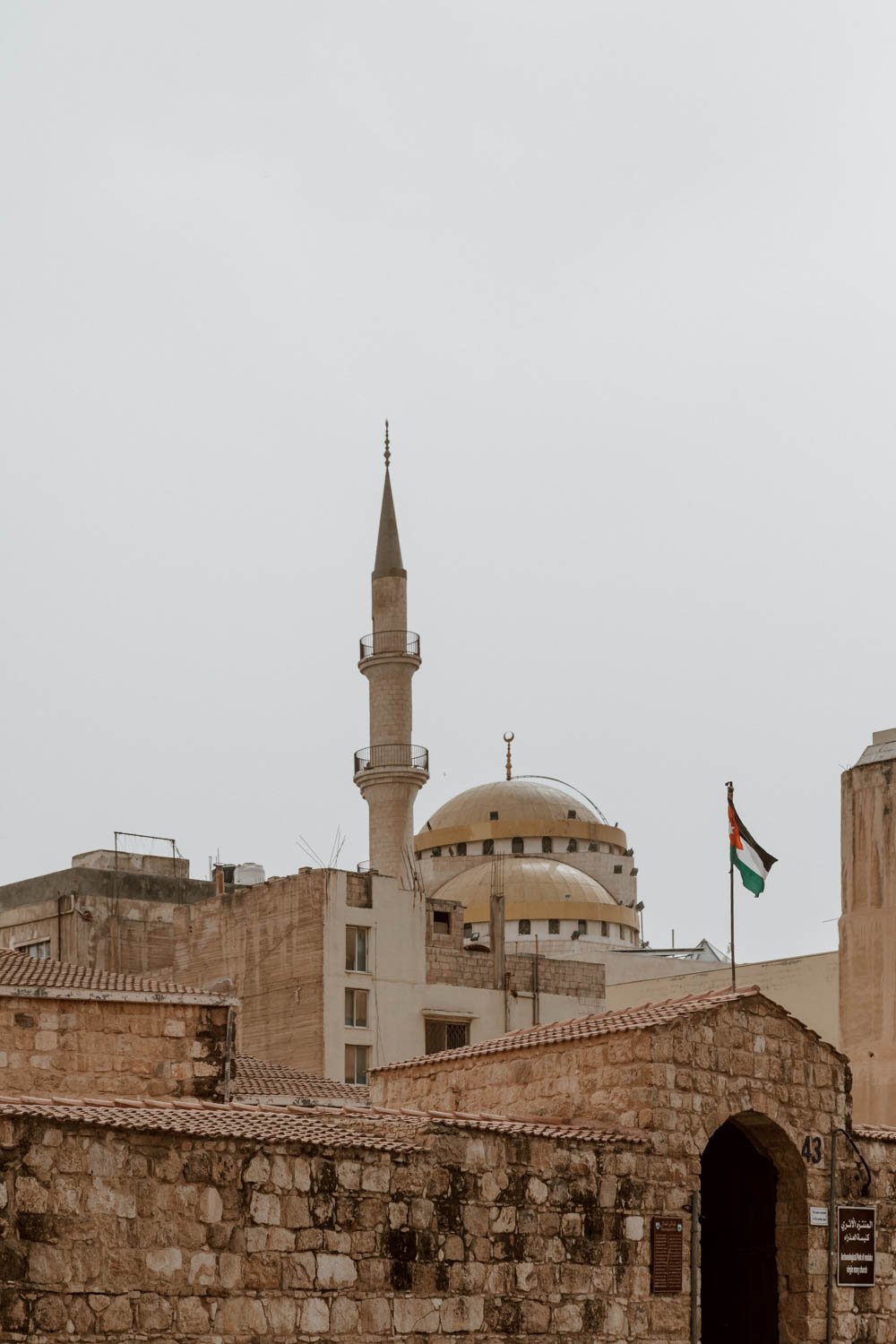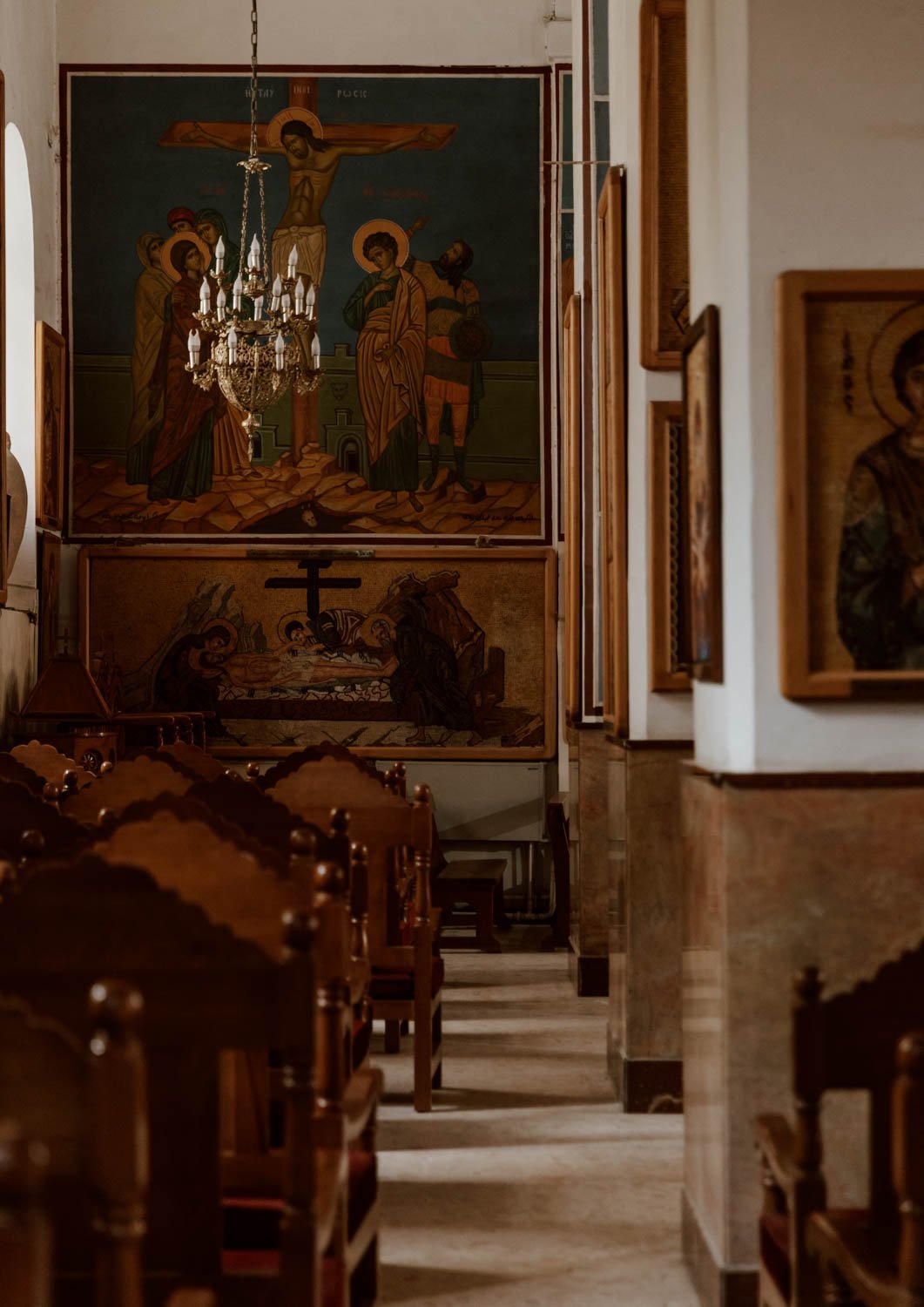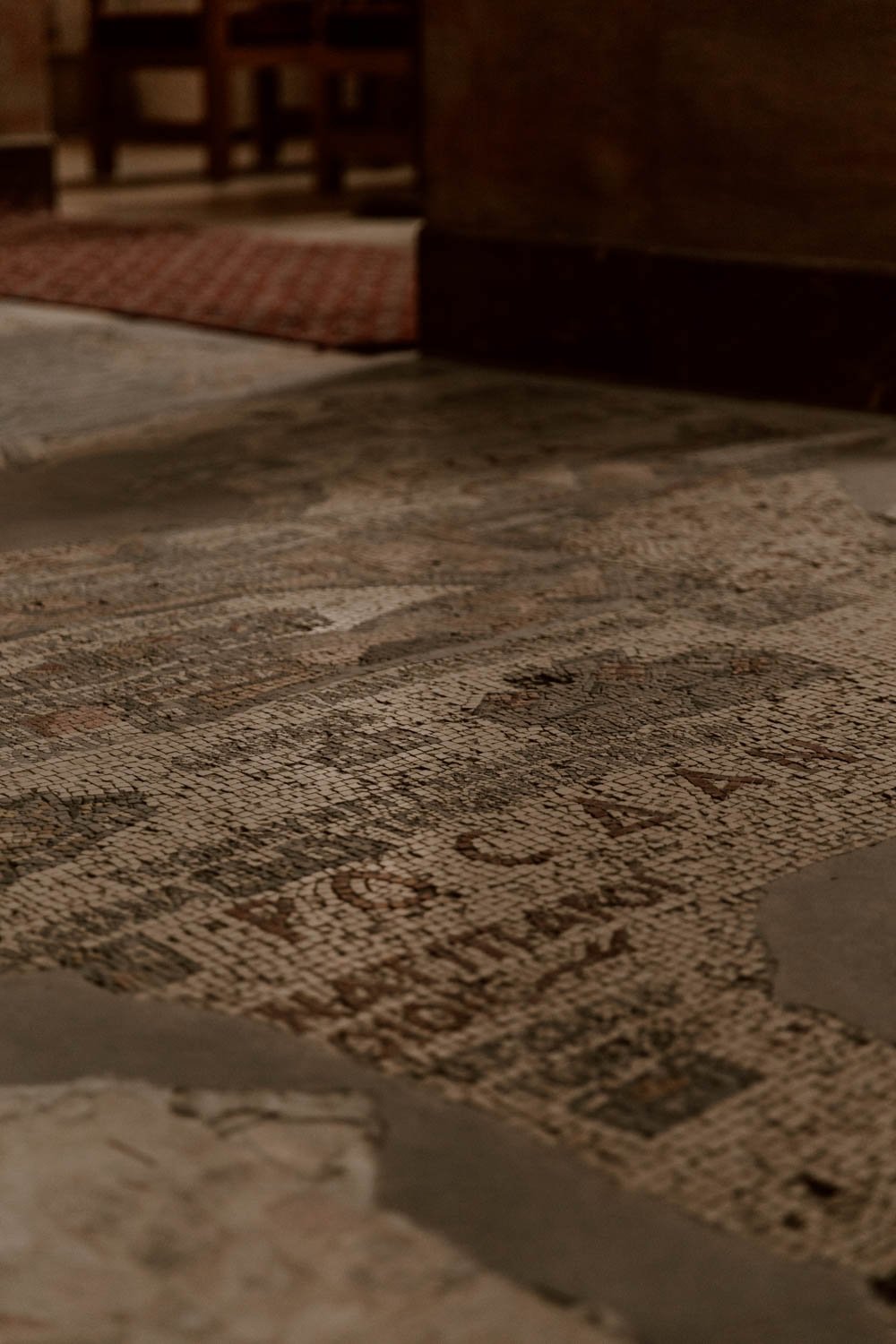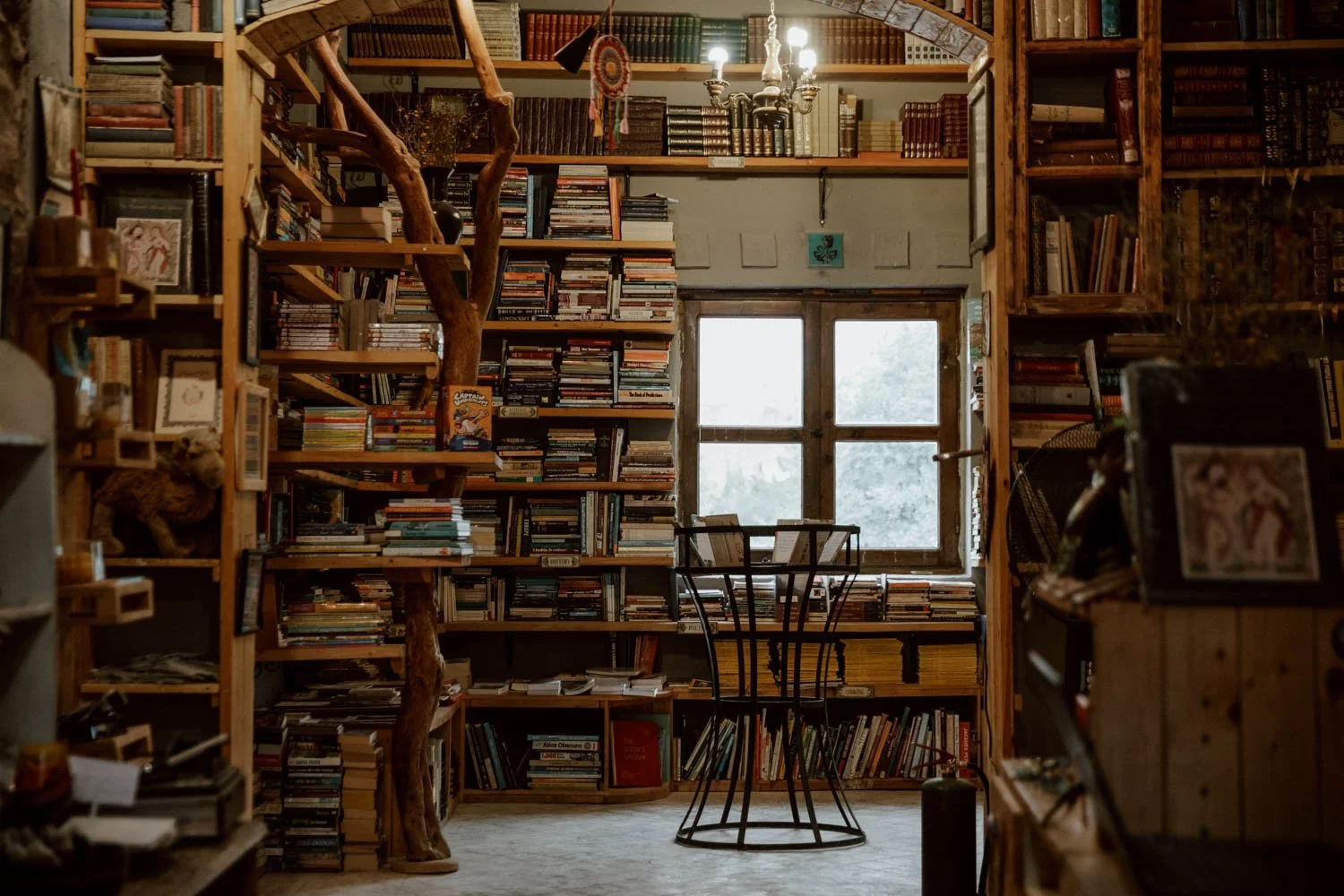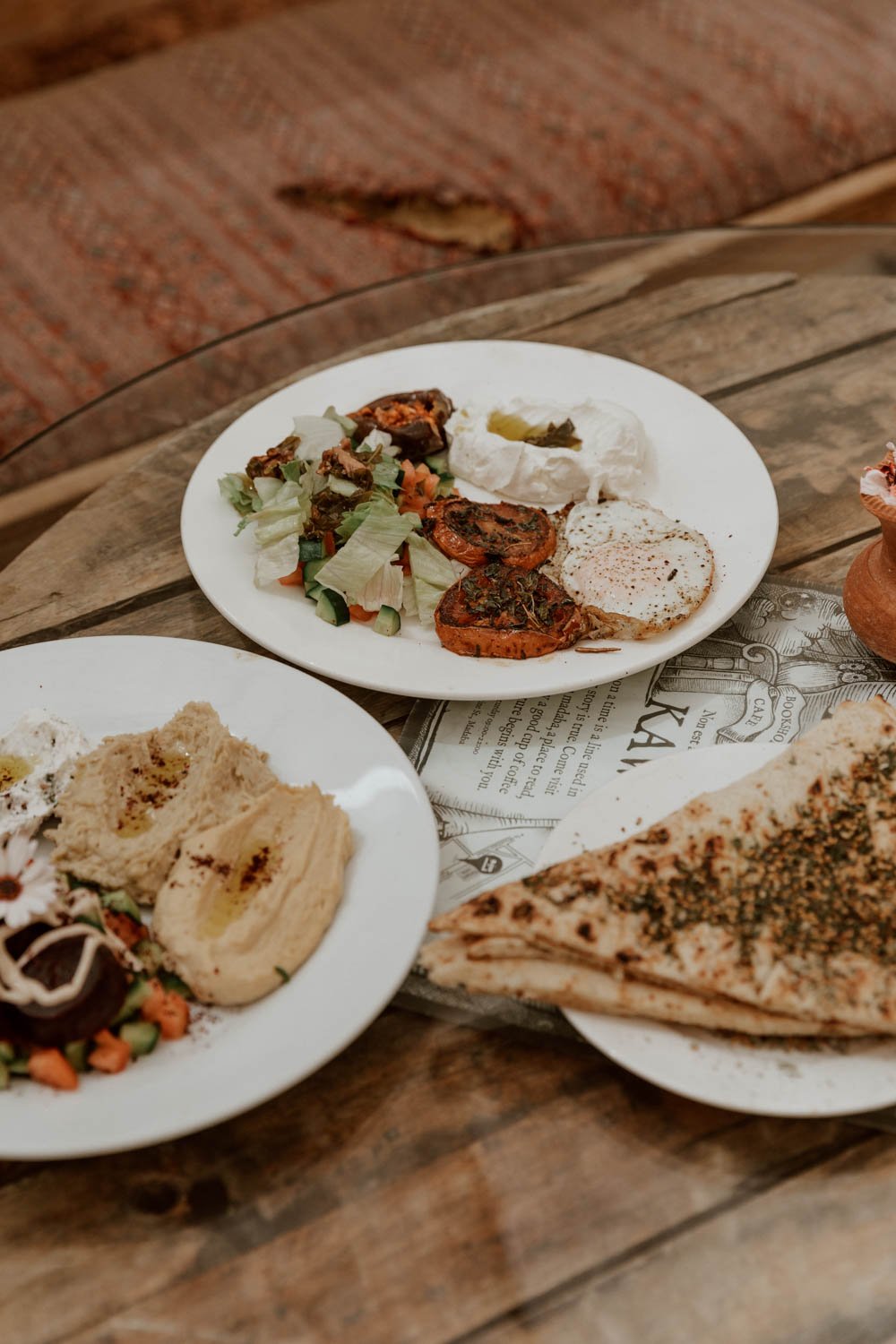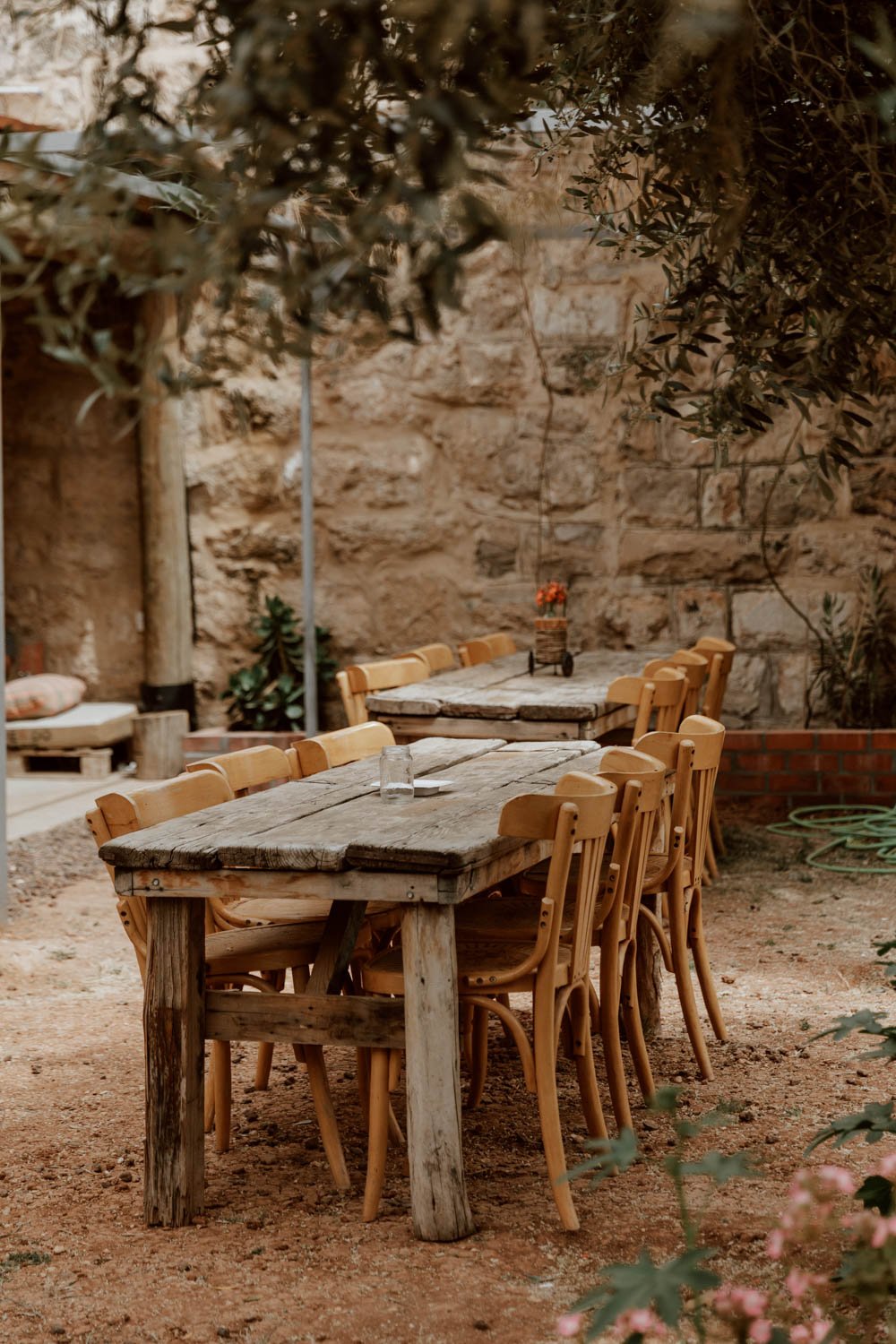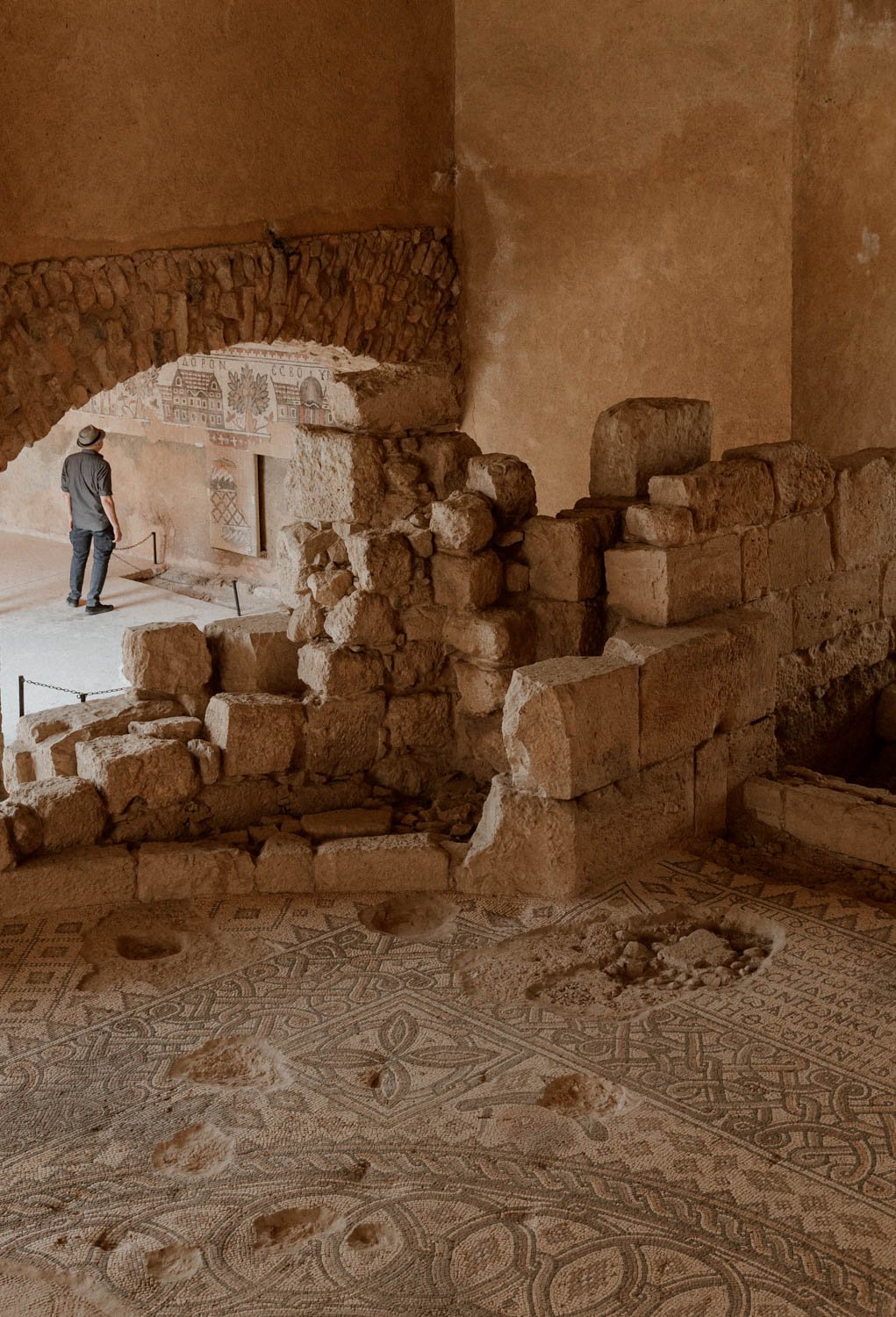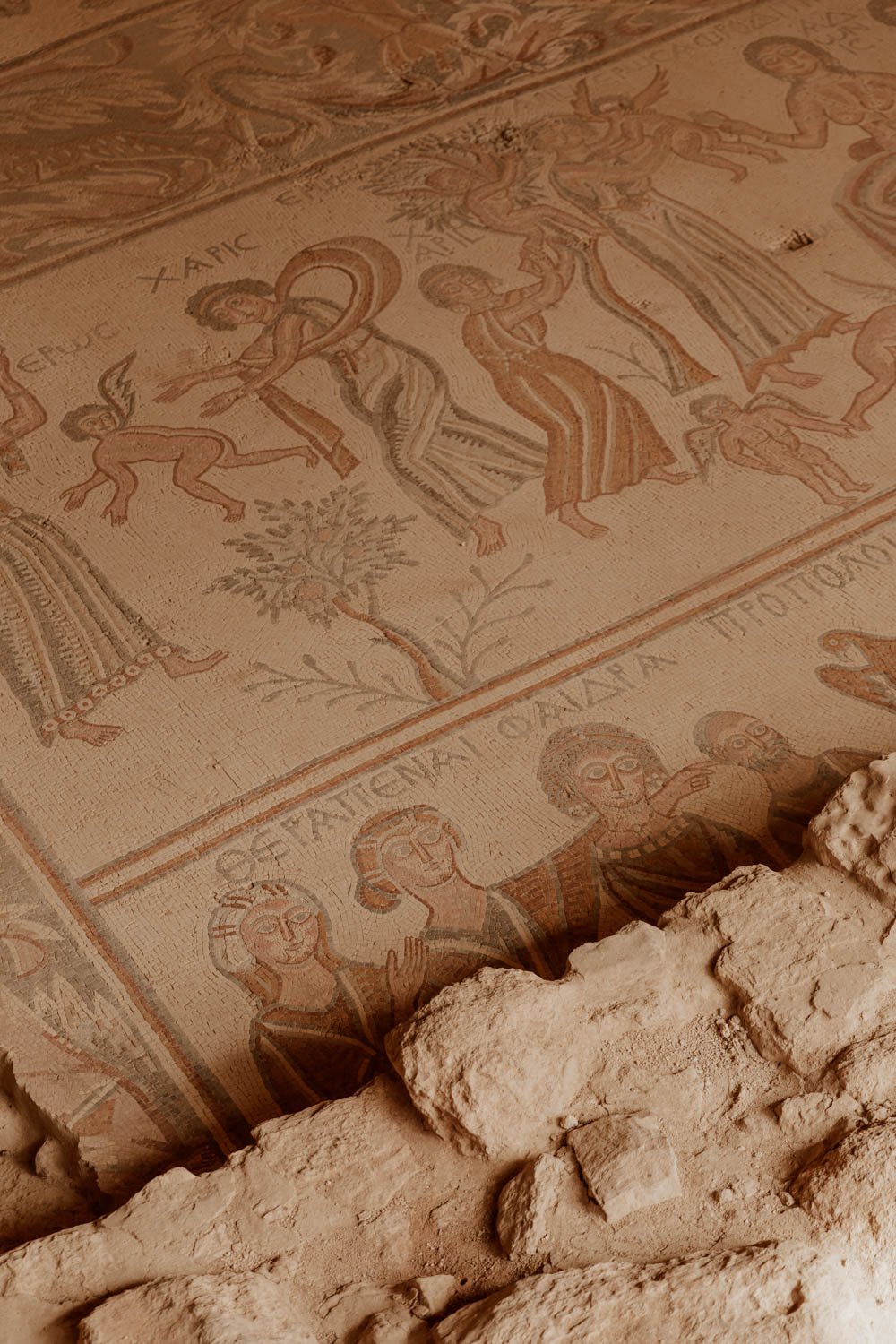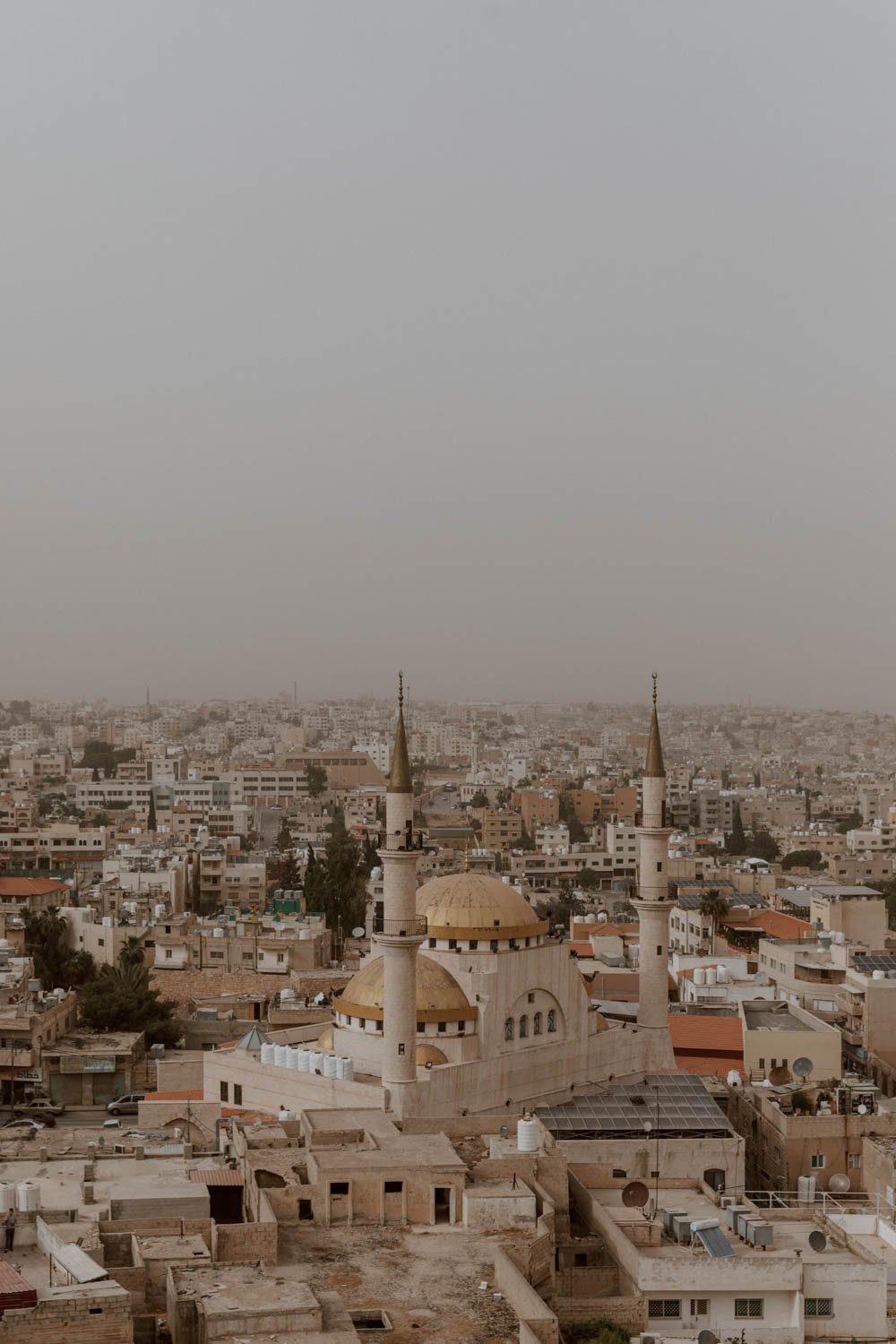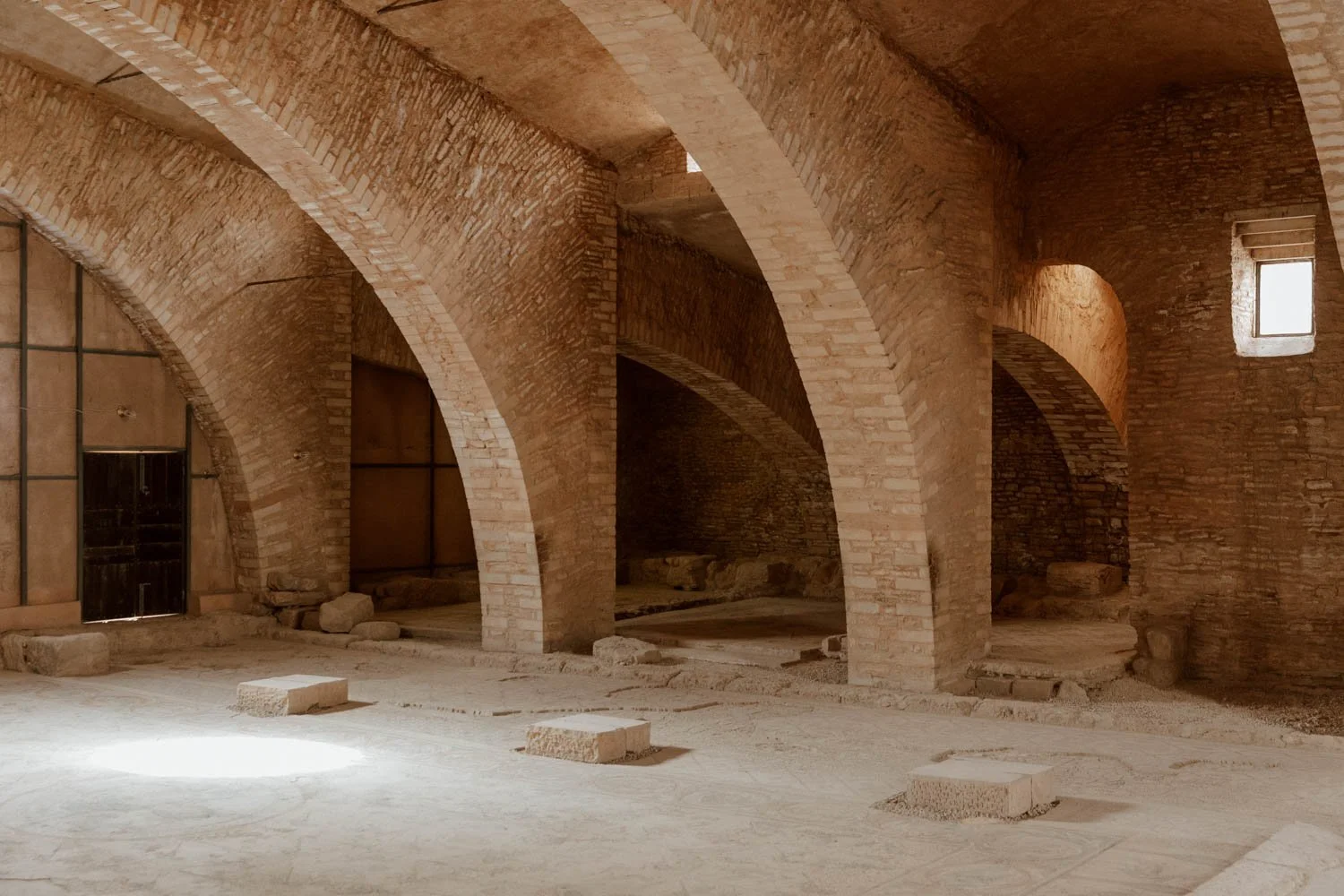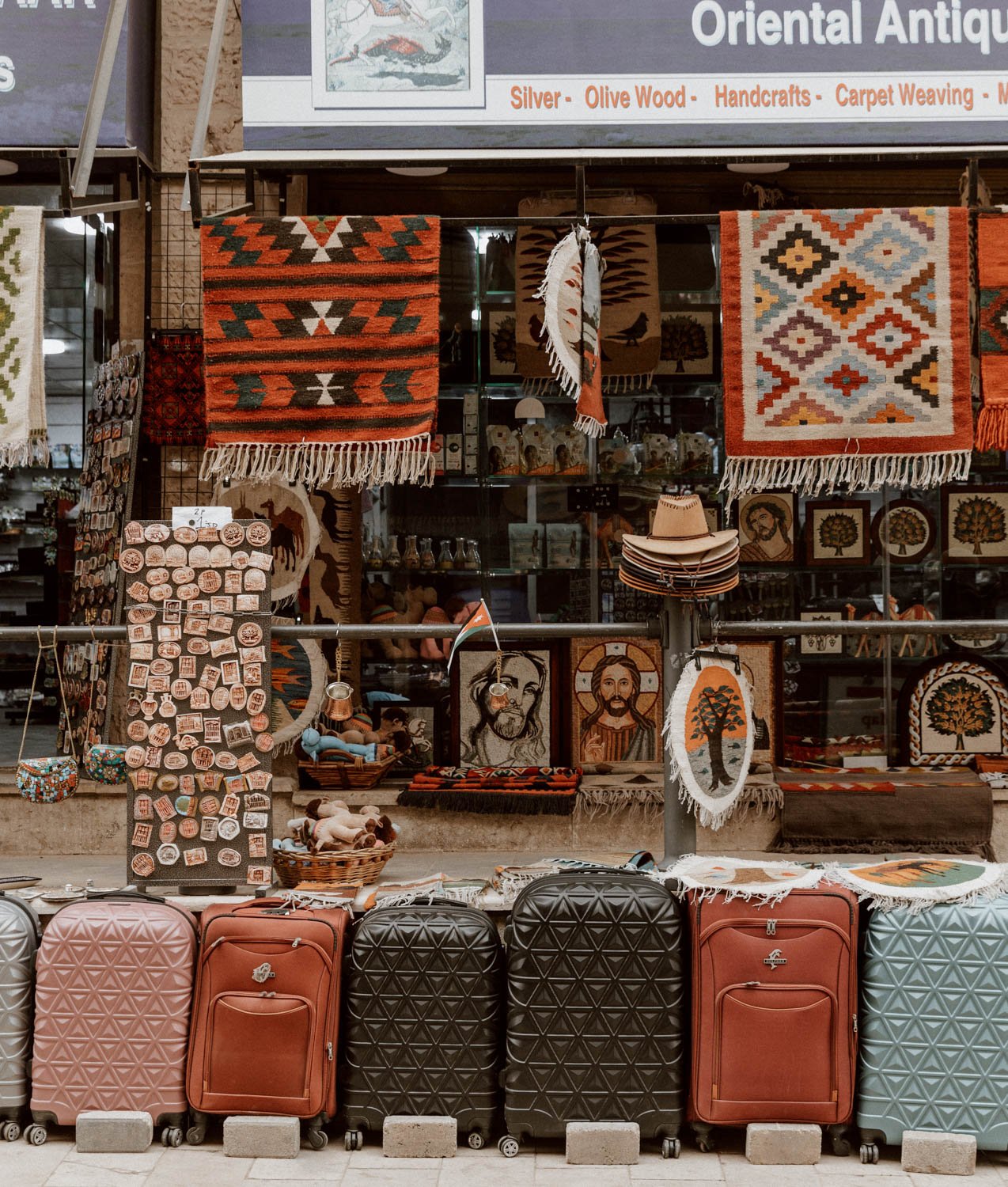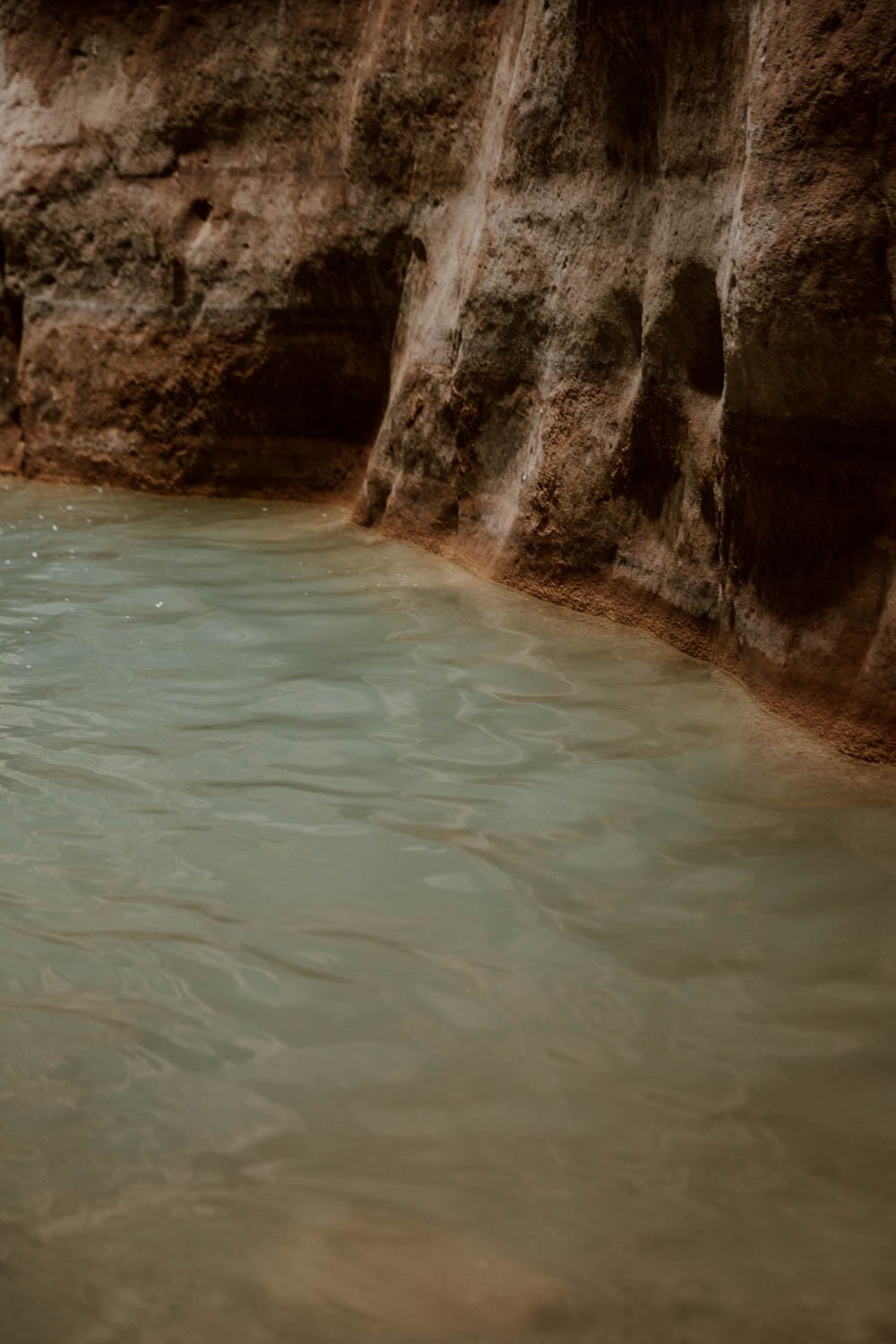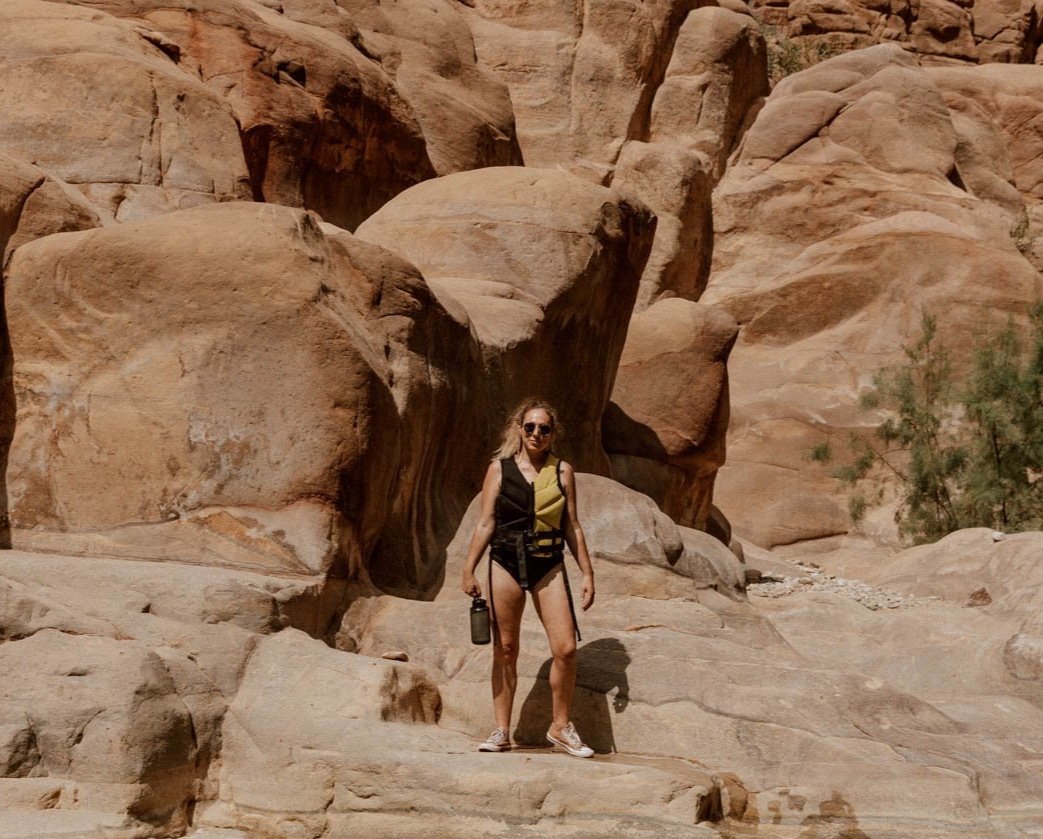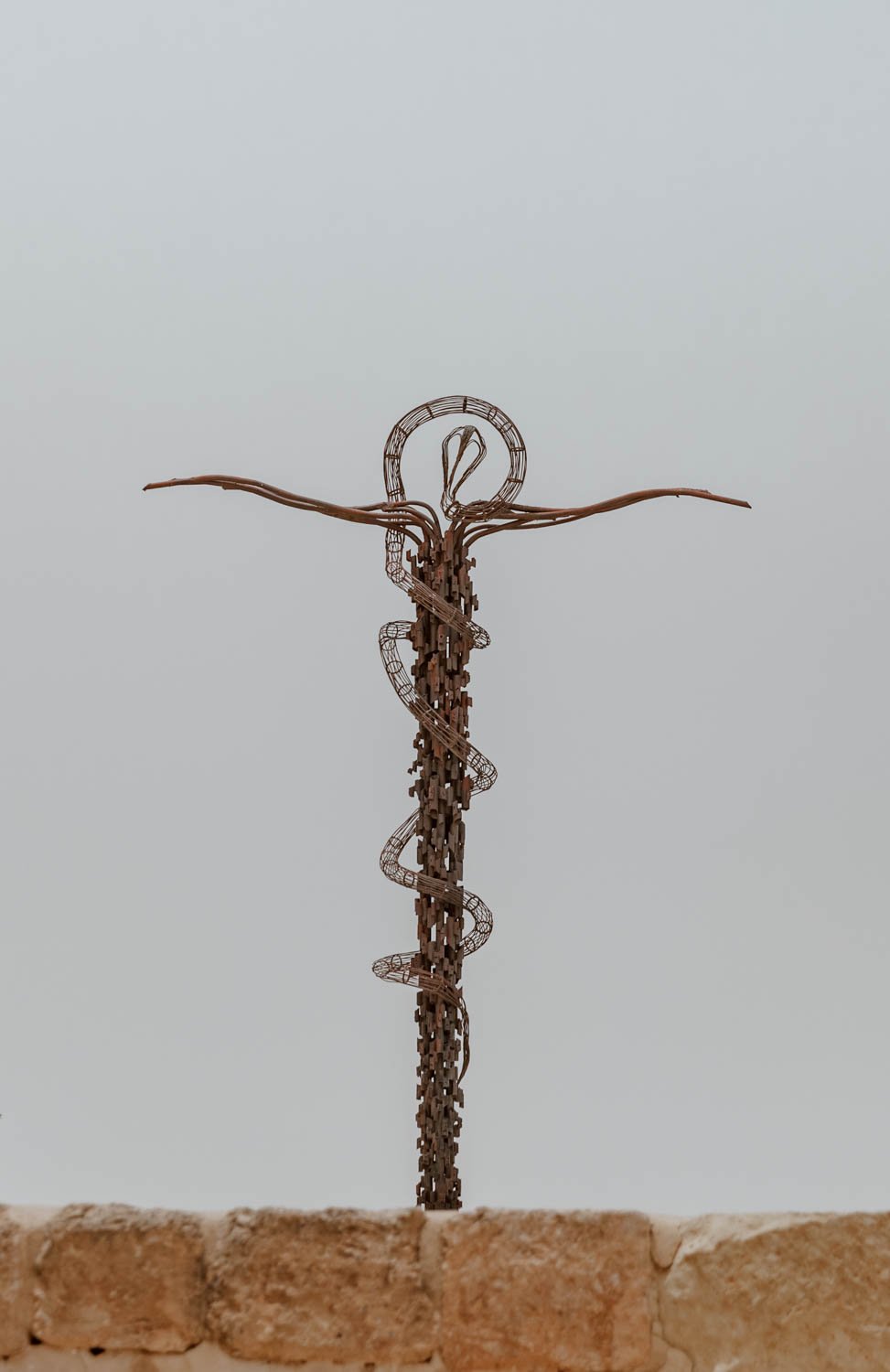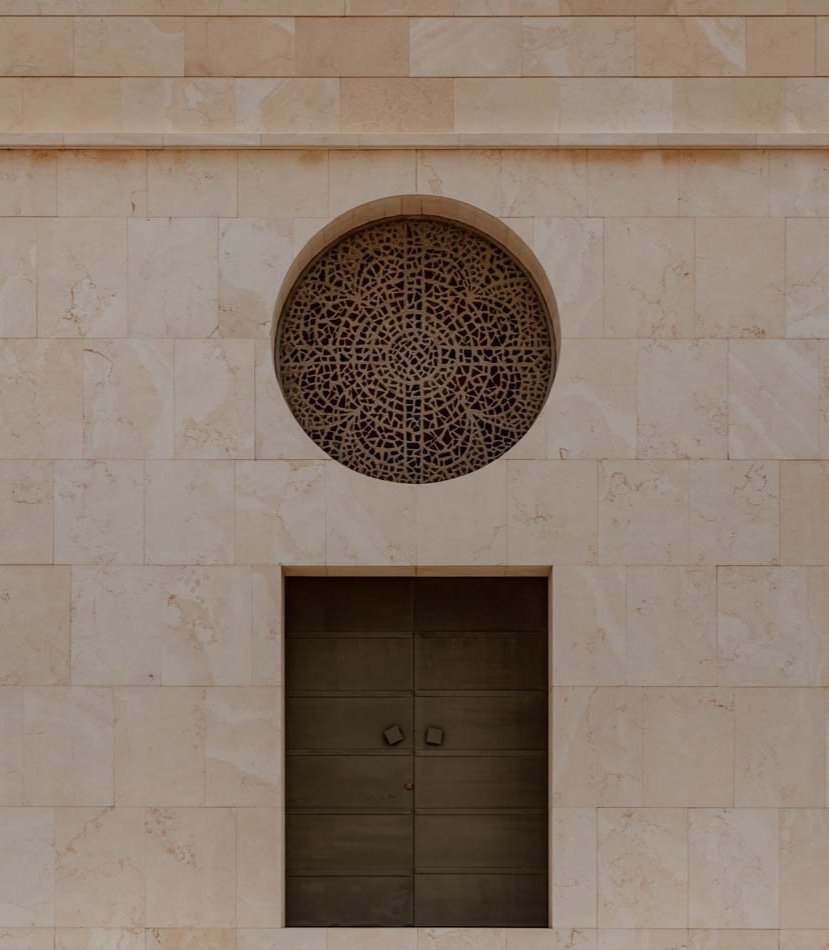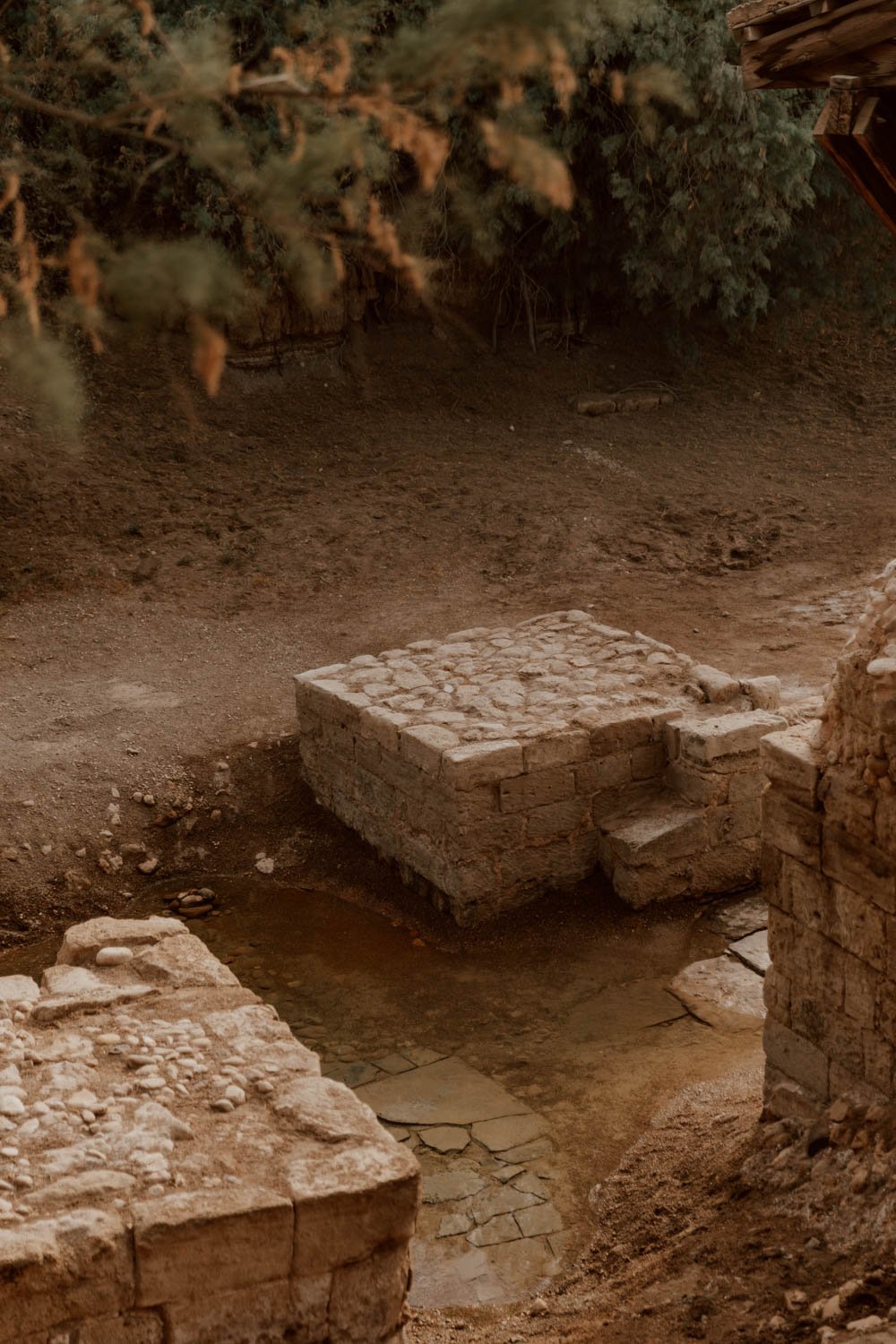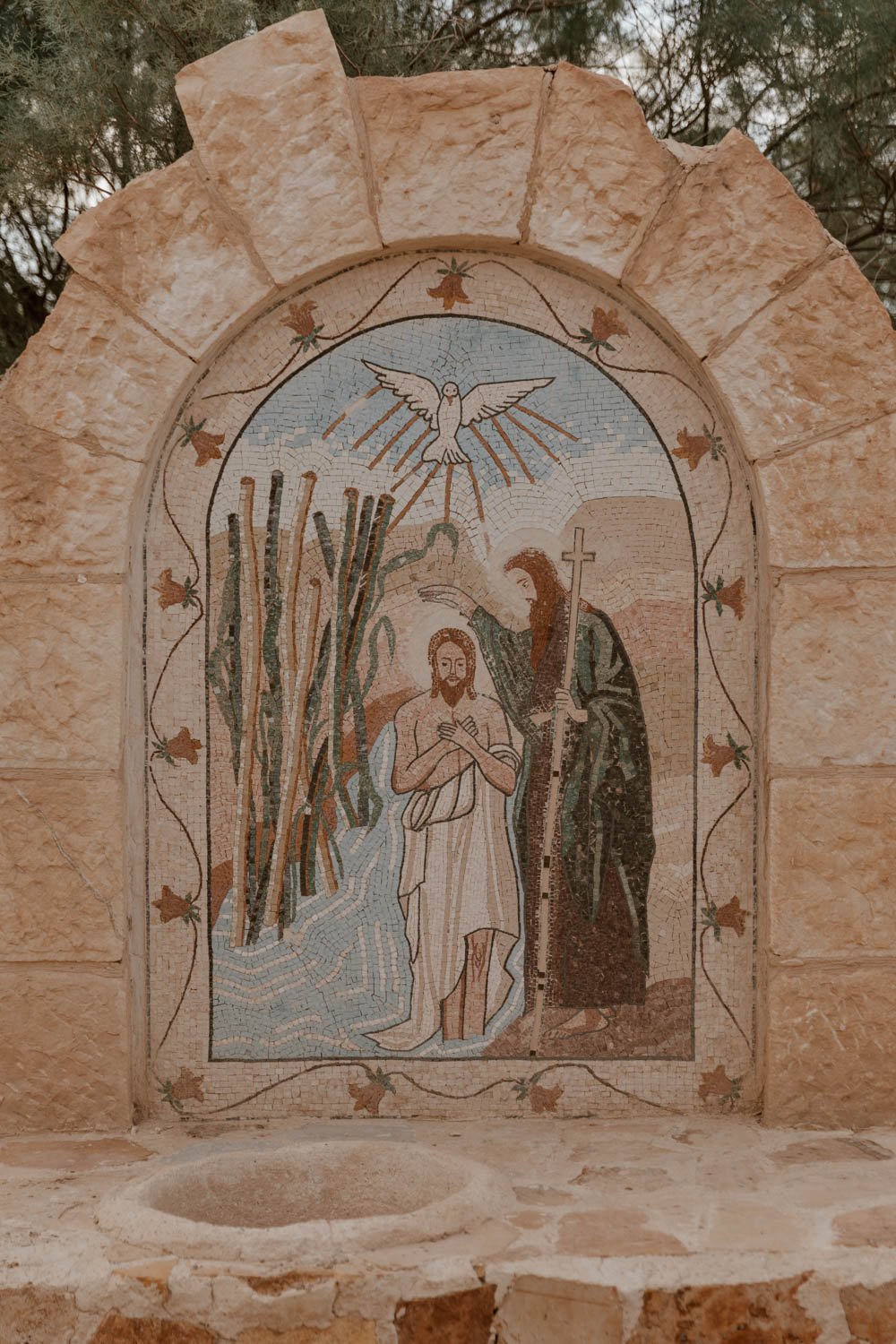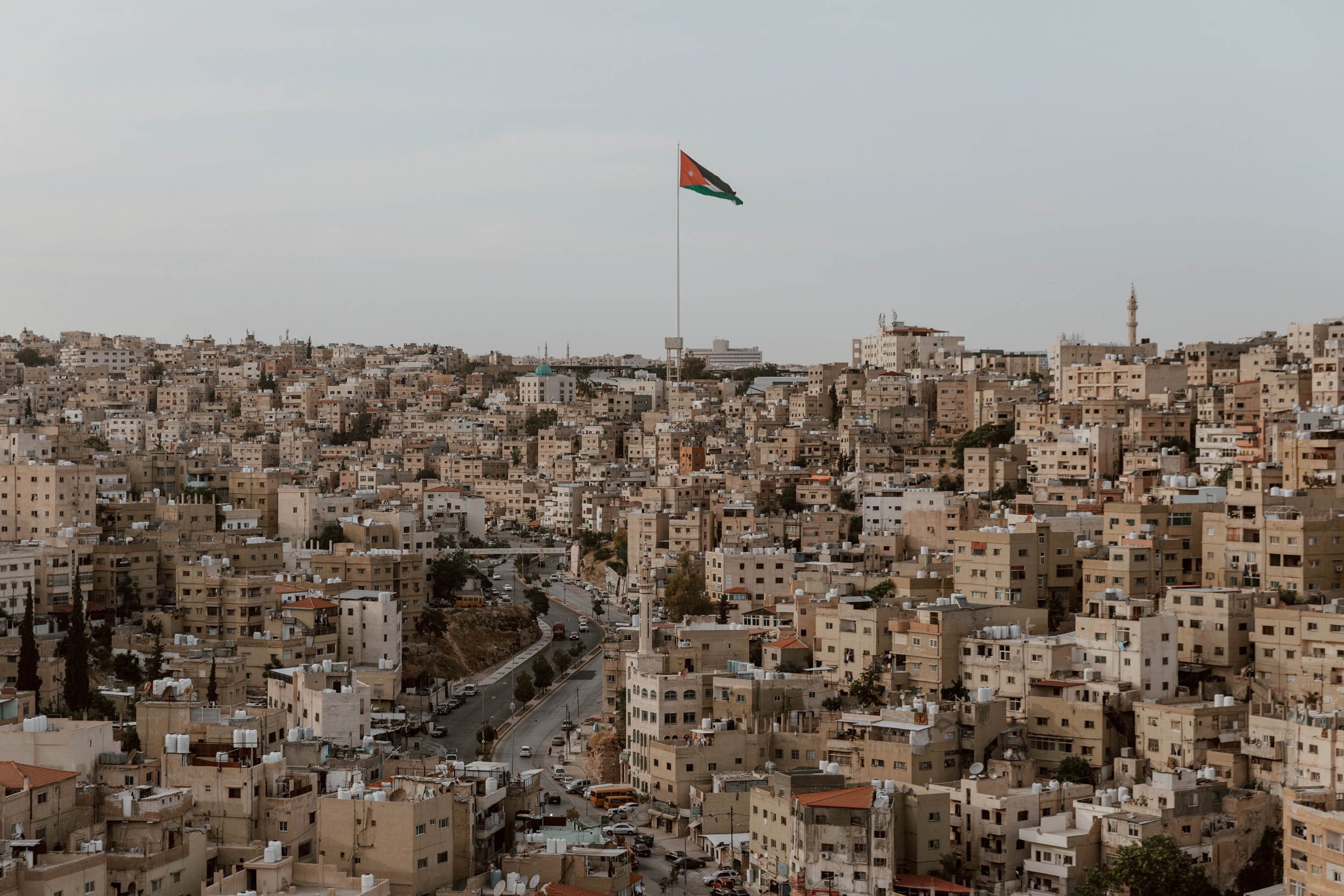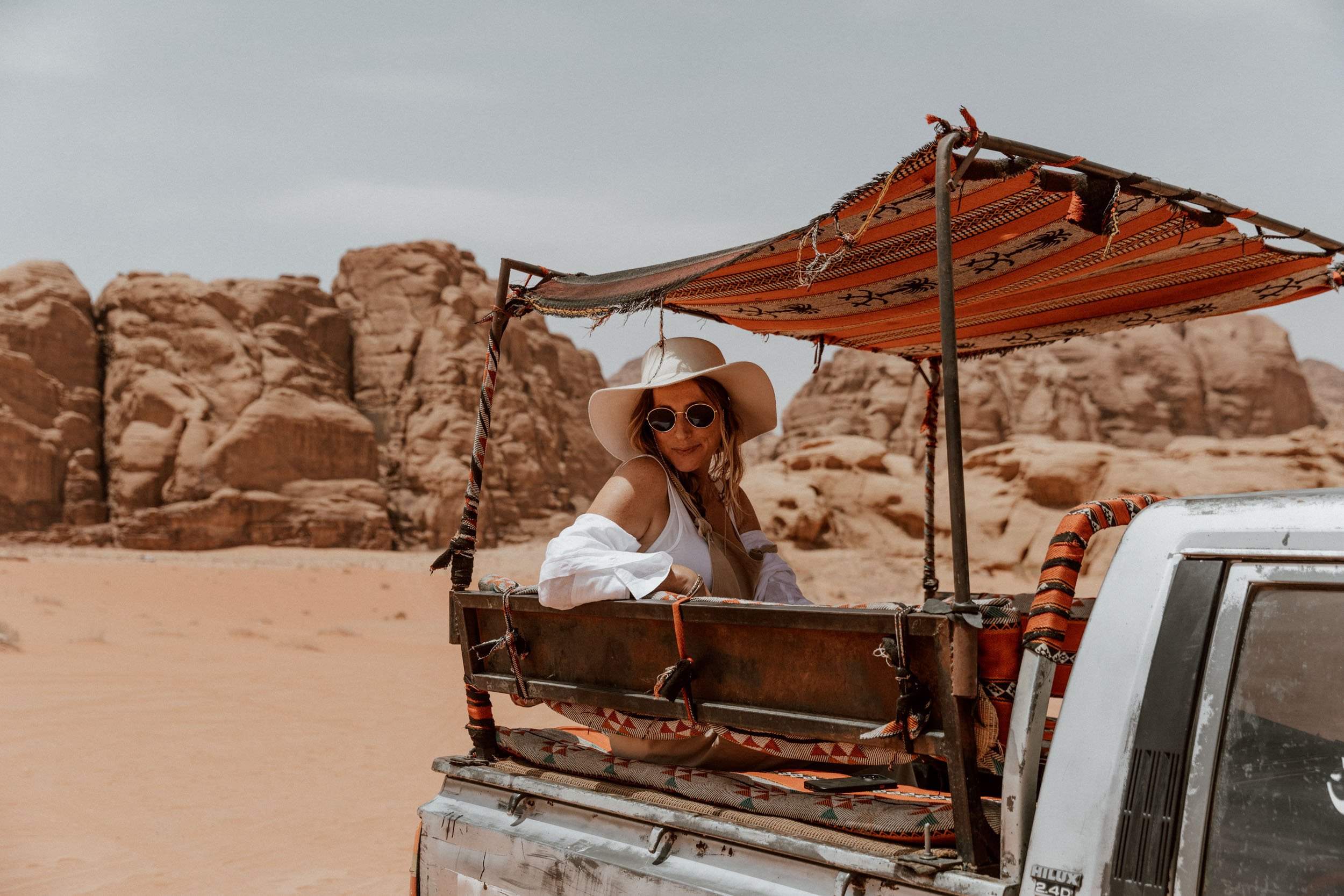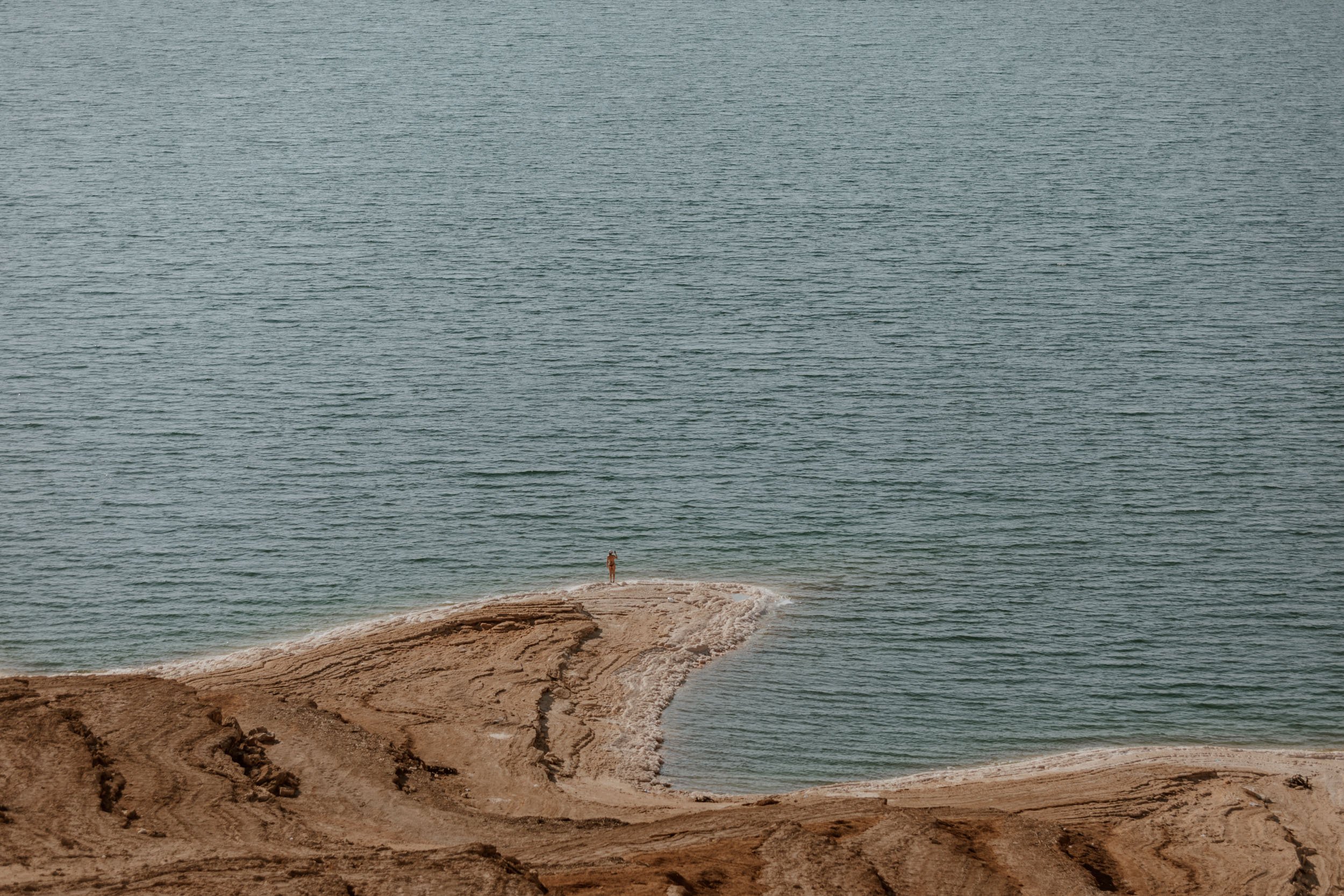With its substantial Christian population, Madaba provides visitors to Jordan with a different perspective on the country, as well as a chance to view some of the world’s most impressive Byzantine-era mosaics. In this guide, discover our favourite things to do in Madaba as well as tips on where to stay, where to eat and why it makes a fantastic base for northern Jordan.
Within the borders of modern-day Jordan, a land whose inhabitants can be traced back more than eight thousand years, the concept of historical age can be difficult to appreciate.
How does one conceive of the significance of a city with roots that were first lain three thousand years before Christ, when the caves that surround the carved city of Petra were occupied more than four millennia earlier?
This is the situation we find ourselves in with Madaba, an ancient settlement that dates back to the Bronze Age, whose course was charted throughout the Old Testament and has been ruled by the Moabites, the Nabateans, the Romans, the Byzantine, the Rashidun and the Umayyad.
Ironically, it is not Madaba’s long history that seals its significance, it is what history almost forgot; following a devastating earthquake in the 8th century, for more than a thousand years the city of Madaba was lost.
____
Despite conquering Muslim forces arriving in the 6th century, a small but enduring Christian population survived in Jordan; in the 19th century, spurred on by local fighting, two thousand of those Christians fled Karak for a new life amongst the dust and destruction of old Madaba, returning to the land that gave birth to many of their forefathers.
First occupying caves, they soon began building directly atop the ancient city. Imagine their surprise when upon digging foundations, they uncovered the remains of a once flourishing Byzantine provincial town; churches, villas, roads and - most significantly - extraordinary mosaics.
These mosaics will shape much of your time in Madaba, but this is not the only reason to visit. Part of what we enjoyed so much about our few days there were the tangible differences between this city and elsewhere in the country.
You see, Madaba feels both at the same time very Jordanian, and very different to elsewhere in Jordan.
The call to prayer to still echoes across the sky five times a day, but this is joined by bells from several Orthodox churches that sit within the same city limits; the ubiquitous Turkish coffee shops can be found on every corner, but on every other corner they are joined by official liquor stores; women glide along the streets in brightly coloured abayas, but chat with women whose religion doesn’t mandate them to cover their hair.
For this reason alone, Madaba should be on your itinerary, but if looking for a more practical excuse to venture to the city of mosaics you will be pleased to know that Madaba makes an excellent alternative base to the nearby capital city of Amman - especially for those who hire a car. It’s far less congested, much more compact, easier to navigate (important if it’s your first day behind the wheel in Jordan), closer to the airport and really well located to explore northern Jordan.
In this guide we’ve covered our favourite things to do in Madaba as well as manageable day trips, our pick on where to eat and the only place you should stay (this fantastic guesthouse)!
This is our guide to Madaba, the city of mosaics.
Our Favourite Things to Do in Madaba
be awed by the mosaic map at St George’s Church
A large part of your time here will be spent exploring the intricate floors designs of old Madaba, but there is one mosaic in particular which changed the modern course of this old city; the Madaba Map.
Rediscovered in 1884, and now part of the floor of the peaceful Greek Orthodox St George’s Church, the 6th century Madaba Map is, to this day, the oldest known map of the Holy Land, and the most exact before modern cartography was developed.
Designed by an unknown artist, and based upon the Bible itself aswell as the Onomasticon of Eusebios - a sort of directory of place names written some time in the early 4th century - this vast mosaic (at least 15 metres by 6 metres) was composed of more than two million pieces of coloured stone, and encompassed a geographical sweep from Lebanon in the north and the Nile delta in the south, to the Mediterranean Sea in the west and desert in the east. Jerusalem was, naturally, at its centre.
The exact purpose of the map is of great debate amongst historians, religious scholars and academics. Some believe it was created to help guide pilgrims to the Holy Land, others believe it to represent Moses’ vision of the Promised Land from nearby Mount Nebo, and many feel certain that its presence was to enhance the spiritual experience of worshippers during Christian prayer.
Fire, earthquake and wilful neglect has regrettably destroyed much of the original design, but what remains continues to be considered to be one of the most important archaeological finds in this region of so many wonders.
Two hundred years have passed since the Christians returned to Madaba, but their desire to build anew has put Madaba very much back on the map.
The Essentials | The church is open 9.30am to 5pm on Fridays all year, 8am to 5pm Saturday to Thursday in the winter (November to March) and until 6pm in the summer (April to October).
The Jordan Pass is not accepted here, with tickets costing 1JD per person (under 12s are free) from the little office to the right of the church entrance.
You can find St George’s Church here on Google Maps. Note that on Friday and Sunday mornings the church opens at 7am for Mass, to which visitors are welcome but viewing of the map at this time however is not permitted.
We chose to visit the church by ourselves and without a guide, bur we must admit that we really didn’t appreciate the gravitas of the site until it came to writing this article and putting in lots of research. If we were to do it all over, we’d seriously consider hiring a local guide to fully appreciate just how special this map truly is as well as talk you through the various symbols, words, and locations on it (quite difficult to decipher otherwise).
As with all religious buildings, remember that this is an active place of worship, and one should dress and act respectfully.
Eat & Peruse at the Kawon Once Upon a Time
“Would ruins enrich your life? They’ll teach you about history, that’s good, but will they take you somewhere else?”
These are the words of Ghaith Bahdousheh, the founder of Kawon Once Upon a Time who in 2016 gave up a safe job working as a risk-analyst to bring books to the people of Madaba. Shocked to discover there were only bookshops in three of the many cities across Jordan, he endeavoured to start his own. From humble beginnings and a small collection of tomes on a restaurant table at the side of the road, his dream of transforming books from a luxury to a cultural necessity has been realised with the creation of Madaba’s first bookshop.
And he didn’t stop there.
With the help of Qais Maaya - who started out as one of the bookshop’s loyal clients, but is now a co-founder - Kawon Once Upon a Time has expanded to become a community enterprise (which allows people to exchange, rather than just buy books), a restaurant and a cultural space.
For us, it offered a breath of fresh air in the heat of Jordan - and one of the few truly vegetarian friendly restaurants we encountered in the country.
If you only have a few hours in the city, we insist you put aside a short time to explore the cave-like bookshop, that is home to a wide variety of titles, in many languages, and spanning multiple decades. For those that have longer, order one of the daily specials scrawled across a chalk-board at the entrance (vegans are as well catered for as vegetarians), and head towards beautifully designed garden to choose your drink.
Oh, and cat-lovers will be delighted to discover that a family of felines also call Kawon home - if you can’t spot them immediately, be sure to check inside the plant pots which seem to be the perfect size to cater for a couple of kittens at a time.
You can find Kawon here on Google Maps.
Opening hours are 9am to 10pm every day.
Explore the Archeological Park
Following careful excavation and restoration in the 1990s, an entire section of Madaba’s historical centre - once residential properties - has been given over to the creation of an open-air museum, known as the Archeological Park.
Housing a collection of mostly Byzantine ruins and colourful mosaics, the Archeological Park is actually composed of two sections: one in the eastern section of Madaba’s historic centre, and one in the west, but they can be paired up quite easily.
Archeological Park I (Eastern Section)
Highlights include:
Mosaic from Machaerus | One of the first exhibits you’ll see upon entering is a fragment of a 2,000 year old mosaic from the bathhouse of Machaerus, a palace built by Herod the Great (the ruins of which can be found 15 kilometres south of Madaba). Astonishingly, it is believed to be the oldest mosaic found in Jordan.
As we said, the concept of historical time here hits different.
The Church of the Virgin Mary | As we mentioned in our introduction, Madaba has long been associated with Christianity, but it was the building of four churches at the beginning of the 7th century that really cemented that identity. Unearthed beneath the floor of a private house in 1887, the Church of the Virgin Mary was one of those four, and its most enduring and impressive feature is the geometric central mosaic thought to date from 767 AD. The crypt beneath the church is actually the remains of a Roman temple.
Hippolytus Hall | Within the large roofed structure you will find this 6th century Byzantine villa, so-called for its elaborative figurative floor design that depicts the ancient myth of Hippolytus. Of all the mosaics on display within the Archeological Park, this is perhaps the one we were most impressed by, due to the colours, size, intricacy and immaculate condition.
The entrance to this section of the Park can be found here. It’s free to holders of the Jordan Pass (you will just need to list your name and nationality within a visitors book), but 3JD without.
Archeological Park II (Western Section)
In our opinion, Archeological Park II is a little less impressive its partner, but its inclusion within the Jordan Pass means that it’s worth popping your head in when passing by.
Highlights include:
The Burnt Palace | The most impressive highlight in this section of the Park are the remains of what was once a luxurious Byzantine residence, so named the ‘Burnt Palace’ for the earthquake and fire that destroyed it in 749 AD. Some elements of the building itself remain, but its most impressive features by far are the relatively intact mosaic floor designs.
The Church of the Holy Martyrs | This 6th century basilica (known locally as the Church of al-Khadir) was excavated in 1966 and features a large mosaic floor. Due to various bouts of damage throughout its history, a little bit of imagination is required to appreciate the design.
The entrance to this section of the Park can be found here.
The Essentials | The Archeological Park is open 8am to 4pm between October & April, and until 5pm May to September. Entry is free to holders of the Jordan Pass, or tickets cost 3JD per person (free for under 12s) - you will just need to list your name and nationality in a visitors book. This ticket covers entry to both sites, as well as the Madaba Museum and the Church of the Apostles.
Get Lost in St John the Baptist Church
Of all the historical sights in Madaba, the Church of the Beheading of John the Baptist was undoubtedly our favourite - but perhaps not for the reasons you might expect.
The church itself is a relatively modest 20th century affair, built in 1913, as the name suggests, at the probable site of the beheading of John the Baptist (a fact confirmed by the Vatican in 1967). Take a moment to reflect, to appreciate the feeling of peaceful calm that accompanies holy places such as these, and cast your eye over the very unique, very Madaba hanging mosaics of Biblical scenes.
The real star of the show however lies beneath the vaulted belly of this modern creation - the 3,000-year-old acropolis of Madaba upon which it sits.
Here, beneath the church, you will follow a narrow maze of dutifully refurbished, stone-lined trails that trace their way through the ancient citadel. We mention Madaba’s long history repeatedly in this article, however it is perhaps here, wrapped in an abundance of visual clues (including a still-functioning well that dates back to the Maobite era), that you can appreciate it the most.
Once you’ve explored what lies beneath, it’s time to head up high, to the top of the cramped belltower for the best view of Madaba. The climb requires a little manoeuvring around bells and ropes, as well as some pretty steep ladders - best not attempted by those with limited mobility or a fear of heights - but it’s well worth the effort.
The Essentials | The church is open from 9am to 5pm October to April, and until 7pm May to September. Note that it is closed to tourists during the daily mass, but visiting worshippers are welcome to attend the service. Entry is not included in the Jordan Pass, but tickets can be bought for just 1JD per person (free for under 12s - cash only).
Find St John the Baptist Church here on Google Maps.
Top tip // The room where you buy your tickets (it’s actually a small 19th century chapel) has a wonderful collection of black and white photographs dating from 1902 to 1911 which we highly recommend making the time to peruse.
Church of the Apostles
Whilst we appreciate you may be somewhat churched-out by now, there is one more we wanted to bring to your attention: the Church of the Apostles.
This rather insignificant looking church (extensively restored in 1993) houses a large, rather impressive central mosaic which you can view from the raised internal platforms. It’s a bit of a walk away from the main historical centre, so we’d say you could leave it off the to-do list if you’re running short of time (it was a bit of a building site when we went).
Entrance is included in the Jordan Pass, or without is 3JD per person. Find it here on Google Maps.
Wander Along Tourist Street
Otherwise known Al-Amir Hasan Street (or occasionally as the small street that branches off of it), this short section of pedestrianised road offers the Madaba tourist experience in a microcosm - shops selling everything from religious icons to colourful rugs, Turkish coffee pots to Dead Sea masks, alongside comfortable dining options, and several tour operators.
Whether you come to Madaba for an afternoon or stay for a few days, you will inevitably pass along this street more than once.
Amongst the shops selling fairly generic tourist tat, there are actually a number of really wonderful antique and curio shops (specifically towards the end of the street, after the entrance to the Archeological Park, on the left hand side). Honestly, we could have filled a suitcase! Unfortunately, we were quoted $1,000 for a painting left on the floor outside the shop so didn’t continue to negotiate - there was an element of language difficulties, so we’d recommend giving the bartering process a go yourself!
At the end of the street you will find Frankfurter Supermarket, marked out by the wall mosaic of Leonard Cohen. This is an excellent place to stock up on local specialities like baklava, za’atar, and sumac, all at very reasonable prices before popping into the as yet unnamed hipster-ish coffee shop opposite (owned by the same chap).
As we’ve mentioned, this street - and the ones running off of it - are also where you’ll find the majority of the proper sit-down restaurants:
Mystic Pizza. Yes, we know - you didn’t come all the way to Jordan to eat pizza. But if, like us, you’ve eaten falafel and humus for 10 days straight on a Jordan road trip, a few slices from here will taste like nectar from the gods. It was actually surprisingly decent pizza! Find it here.
Fokar. Standard Jordanin cuisine with decent veggie options and good portions. Really popular spot with tourists as well as locals. Find it here.
Jaw Zaman. Very similar menu to Fokhar and directly opposite, but the food here was some of the most expensive we saw during our two weeks in Jordan. They do however have a decent wine/beer menu and a hidden away terrace at the top, so if you’re craving an alcoholic drink with your dinner, you may be prepared to swallow the prices. Find it here.
Adonis. Located in a beautifully restored residence, Adonis is regarded as one of the fancier restaurants in town. We were highly recommended it by our guest house owner but unfortunately the menu wasn’t terribly veggie friendly when we stopped by. Gorgeous setting though. Find it here.
Ayola. This restaurant is super popular with tourists but each time we passed it was devoid of a single local - which was reason for us to never go in. The reviews are however excellent. Find it here.
The falafel place. Can only find the name of this place in Arabic, but they served excellent, well-priced falafel wraps. ‘Nuff said. Find it here.
Go Canyoning in Wadi Mujib
Whilst Jordan’s most famous wadi - meaning a valley or ravine that is dry except in the rainy season - is Wadi Rum, there are a number of other wadis scattered across the country, including the popular adventure playground of Wadi Mujib Biosphere Reserve.
Extending from the heights of the Karak Mountains down to the Dead Sea, this 212-square-kilometre gorge is known as Jordan’s Grand Canyon and is home to several seasonal and year-round rivers, as well as a whole host of trails that can be attempted by travellers.
The most popular is the self-guided and easily accessible two-kilometre Siq Trail, a veritable assault course of ropes, rocks and fast-flowing water.
Upon arriving into Madaba, we still weren’t entirely sure whether we’d make it to Wadi Mujib. Having travelled as much as we have, we’ve grown accustomed to discovering that ‘must-do’ attractions aren’t always as exciting or unmissable as local tourism brochures may suggest; we worried that this adventure trail may be one such activity.
As it turned out, Wadi Mujib was a real high point from our time in Jordan and, after a relatively sedate couple of weeks on our Jordan road trip (at least physically), it offered a completely different experience that we absolutely relished.
It is however important to note that due to dry season droughts, flash floods, and safety priorities, the Siq trail and two other 'wet' Wadi Mujib trails, are only open from April to the end of October. If visiting between these months, be sure to add it to your itinerary!
We’ve written an entire guide to Wadi Mujib, so recommend heading over there for full details and help on planning your own trip.
Take in the promised land from Mount Nebo
Towering 1,000 meres above the desert and dry farmlands below is one of Jordan’s most important Christian holy sites, Mount Nebo. Known locally as Siyagha, it is the highest point of the ancient kingdom of Moab and where Moses, according to the Old Testament and scholars that have followed, was granted a view of the Promised Land - and where he died soon after.
A place of pilgrimage for early Christians from Jerusalem, a small church was built here in the second half of the 4th century to commemorate the life and death of the man regarded as a prophet by all three Abrahamic religions.
And whilst much has changed, been reconstructed, and redeveloped at this site in the intervening 1,600 years, Mount Nebo’s religious and historical significance remains, as does the opportunity to cast your eyes across that very same view.
Though an important pilgrimage site first and foremost, particularly for Christians, there is also enough here to interest the non-religious traveller, with the spectacular mosaics residing within the walls of the ancient basilica some the best presented you’ll see in the country (better lit and presented than those you’ll see in Madaba).
The Essentials | Mount Nebo is locating a just a 15-minute drive from Madaba so is easily accessible for those with a rental car.
If you’re not doing a Jordan road trip - and therefore don’t have your own vehicle - we’d recommend taking a shared taxi from Madaba for around 1JD per person, or a private taxi for 5JD (8JD return, with one hour waiting time).
Entry to Mount Nebo is not included within the Jordan Pass, and instead costs 3JD per person.
If you’d like to find out more, or are looking for help in planning your own trip out to Mount Nebo, be sure to take a look at our ‘Complete Guide to Visiting Mount Nebo’
Visit the Dead Sea
Located at 408m below sea level, the Dead Sea - so called for a salinity so high that no life can exist within its depths - is the lowest point on Earth.
And floating atop its surface is an absolute must do for any visitor to Jordan.
Many visitors to northern part of the country choose to do this whilst spending a night or two at one of the Dead Sea Resorts (especially if they want to get in a mud mask too), but for those who either don’t particularly enjoy the somewhat sanitised experience of a luxury hotel, or would prefer to save their money for other experiences within the country, the good news is that Madaba is ideally located for a day trip to the Dead Sea.
In fact, for those that have their own rental car, you can follow the spectacular road through the mountains and make it to the Dead Sea in less than an hour!
If you really do have your heart set on a night at one of those fancy resorts we mentioned, we’d suggest either the Mövenpick Resort & Spa or the Dead Sea Marriott Resort, both of which have excellent reviews, their own private beach and access to mud pools.
Top Tip // Given the fact that the Wadi Mujib access point is on the Dead Sea Highway, we’d recommend combining the two attractions into the same day trip from Madaba.
Plan ahead with our guide to visiting the Dead Sea in Jordan.
Other Possible Day Trips From Madaba
Bethany Beyond the Jordan
Even if you’re not particularly religious, it’s difficult not to be moved when visiting Bethany Beyond the Jordan, the proven site of Jesus’ baptism by John the Baptist.
Lost to the history books for centuries, it wasn’t until the 1994 peace treaty with Israel led to the clearing of landmines that the remains of churches, caves and baptismal pools were able to be safely unearthed. Using Bible descriptions and accounts from 3rd to 10th century pilgrims, scholars were finally able to identify the where Jesus was baptised, a claim sanctified with an open-air mass by Pope John Paul II in the year 2000.
Its location between Jordan and the West Bank mean that it’s only possible to visit Bethany Beyond the Jordan as part of a guided tour, the ticket for which can be added on to your Jordan Pass or purchased separately.
We’ve just published a complete guide on how to visit Bethany Beyond the Jordan, so head on over there for further details and how to plan your time.
Ma’In Hot Springs
Despite a jam-packed itinerary during our two weeks in Jordan, we didn’t quite find the time to visit Hammamat Ma’In Hot Springs, located in the hills above the Dead Sea.
For those with a little more downtime, or keen to relax and soothe those aching muscles after days of walking amongst archeological behemoths and bouncing about in the back of a truck in Wadi Rum, a few hours within the thermal pools waters of Ma’In will likely be just what the doctor ordered!
The Springs now form part of a luxurious resort - Ma’In Hot Springs Resort - and whilst some people choose to stay here and enjoy the area without time constraints, it’s perfectly possible to visit as part of a day trip from Madaba.
A day pass cost to the Springs costs 15JD per person, which gives you access to the public pools or alternatively you can pay 38JD which allows you to use the spa facilities at the resort as well.
Petra
Jordan’s most famous site is about is a straightforward three hours down the Desert Highway from Madaba. If you’re not in a rush, you could even take the scenic route via the Dead Sea and Route 65.
However, for independent travellers, Madaba currently lacks tour offerings or transport connections for Petra. As far as we’re aware, there is no direct bus service from Madaba to Petra, and the alternative would be to get to Amman first by bus or taxi, and make a connection there.
Due to this, we don’t think a day trip from Madaba to Petra is a realistic or desirable option.
Plan ahead with our guide to visiting Petra.
Where to Stay in Madaba
It’s rare that when we put together this section of our guides, that we only really want to recommend one place, but after three nights in the most charming guesthouse, that’s exactly the situation we find ourselves in.
Tell Madaba is owned and run by the most wonderful family, with most people’s first point of contact being a son by the name of Edward. You stay within the family home, in a number of their excellent en-suite rooms, spread across several floors.
From the moment we arrived - greeted with tea and sweet biscuits - until our early morning departure, waved off by a mother who awoke just to offer us a strong coffee, the personal service was just incredible.
There’s a reason they have thousands of exceptionally good reviews!
And no, our stay wasn’t sponsored, it’s just that wonderful - check prices and availability here.
If for some reason Tell Madaba is full, please find below some alternatives:
Madaba Transport Connections
How to Get From Madaba from Queen Alia Airport
As we discussed earlier, Madaba makes an ideal base from which to discover the popular sites of northern Jordan, therefore there will like be many of you reading this article that will fly into the country’s main airport - Queen Alia Airport - and make your way directly to the city of mosaics.
To do this you have three options:
Hire a car | The airport has a wide-range of car rental companies, several of which have offices open 24 hours. We recommend booking on either Rentalcars.com or AutoEurope, both of which aggregate and list most of the local companies as well as the main international brands. We always look + book via them for our rentals, and it often saves money over going direct.
The drive is straightforward and takes around 30 minutes - just watch out for those speed bumps!
Find out more in ‘An Essential Guide to Driving in Jordan’.
Pre-booked Private Transfer | If you prefer the convenience and certainty of an airport pick-up, we’d recommend booking a private transfer in advance. This can be done here.
Taxi | Upon arriving at the terminal you will likely be greeted by taxi drivers touting for business. We recommend politely declining, and heading outside to the official taxi stand. Here you will tell them where you’d like to go, they will give you a ticket and then you pay the taxi driver directly.
The price is fixed, and listed outside the booth. At the time of writing it cost 22.50 JD (the same as a taxi to Amman)
Parking in Madaba
There are a number of car parks in Madaba (both paid and free) in the town centre, just type ‘parking’ into Google when you’re near or try this free parking by the visitor’s centre first.
Alternatively, most of the accommodations will either have parking, or recommend free on-street parking. Tell Madaba have parking on the street outside their building.
Getting Around Madaba
Madaba is a relatively compact city so there is no need to drive or take public transport anywhere; the largest distance we walked was from the centre to the Church of the Apostles, but even in the heat this wasn’t difficult.
Where to Next?
13 Wonderful Things To Do in Jordan
11 Wonderful Things to Do in Amman
A Complete Guide to Visiting Petra
A Guide to Canyoning in Wadi Mujib | The Best Adventure in Jordan
The Perfect Jordan Itinerary (published soon)
23 Thing to Know Before You Visit Jordan (published soon)
17 Things To Know Before Driving In Jordan
Do You Really Need The Jordan Pass?




